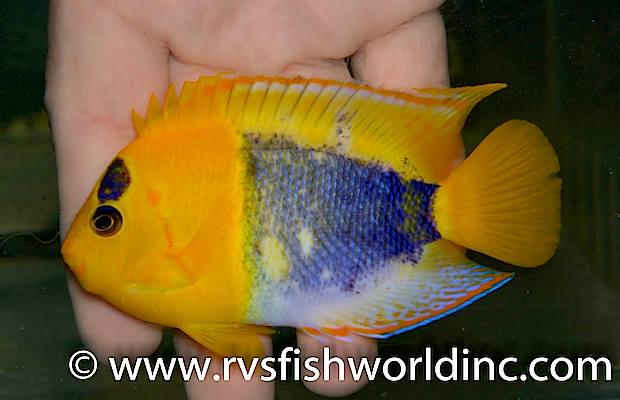Unique angelfish are one of our favorite topics to write on and today we’re lucky enough to bring to your attention three unique Centropyge pygmy angelfish. While sometimes it seems like we’ve seen it all, collections in the Philippines by RVS Fishworld continue to be refined and producing some uncommonly seen reef aquarium fish.
The three angelfish being considered as post-worthy are not all that rare per se, but taken together from the same ecoregion makes us want to give a closer look at how the possible origins of these uncommonly seen fish. All three of the Filipino Centropyge are excellent examples of the dusky yellow “panda” angelfish, a red tailed yellow angelfish, and aberrantly colored bicolor angelfish.
 The Panda anglefish looks more or less like a yellow angelfish, Centropyge herladi, which has varying degrees of dark brown on the face and dorsal fin, with a dusky tail and anal fin. This “form” of the yellow angelfish usually has more rounded dorsal and anal fins, and although these panda angelfish have been appearing irregularly for at least ten years, there’s still very few and far between.
The Panda anglefish looks more or less like a yellow angelfish, Centropyge herladi, which has varying degrees of dark brown on the face and dorsal fin, with a dusky tail and anal fin. This “form” of the yellow angelfish usually has more rounded dorsal and anal fins, and although these panda angelfish have been appearing irregularly for at least ten years, there’s still very few and far between.
The handful of captive aquarium specimens of the panda angelfish that we have observed appeared to be much more skittish than a bold yellow angelfish, an extremely common aquarium fish. Behavior and minor differences does not constitute a new species but perhaps these unusual specimens of Centropyge heraldi are in the process of diverging, even if just a little bit.  The yellow angelfish is known for quite a variability in color form, from the double blackfin male C. heraldi that show up sometimes, to the fish formerly known as Centropyge “woodheadi” and even the unusual vitiligo angelfish specimen. The red-finned yellow angelfish is another morph that we’ve seen once before, but having been collected in a similar area to the bicolor angelfish below, and with obvious similarities in their finnage, we have to wonder if there’s some genetic mixing between Centropyge heraldi and C. bicolor.
The yellow angelfish is known for quite a variability in color form, from the double blackfin male C. heraldi that show up sometimes, to the fish formerly known as Centropyge “woodheadi” and even the unusual vitiligo angelfish specimen. The red-finned yellow angelfish is another morph that we’ve seen once before, but having been collected in a similar area to the bicolor angelfish below, and with obvious similarities in their finnage, we have to wonder if there’s some genetic mixing between Centropyge heraldi and C. bicolor.  Some bicolor angelfish truly have aberrant coloration and but the specimen above has a little more going on than just an excess of yellow color. As you can see there’s a similar red trim motif to the dorsal and anal fins and the blue crown especially is reduced just like in this unusually colored yellow angelfish. We may not have the tools to genetically analyze what is truly going on in these remarkable pygmy angelfish but there’s no harm in making a note of their similarities.
Some bicolor angelfish truly have aberrant coloration and but the specimen above has a little more going on than just an excess of yellow color. As you can see there’s a similar red trim motif to the dorsal and anal fins and the blue crown especially is reduced just like in this unusually colored yellow angelfish. We may not have the tools to genetically analyze what is truly going on in these remarkable pygmy angelfish but there’s no harm in making a note of their similarities.



